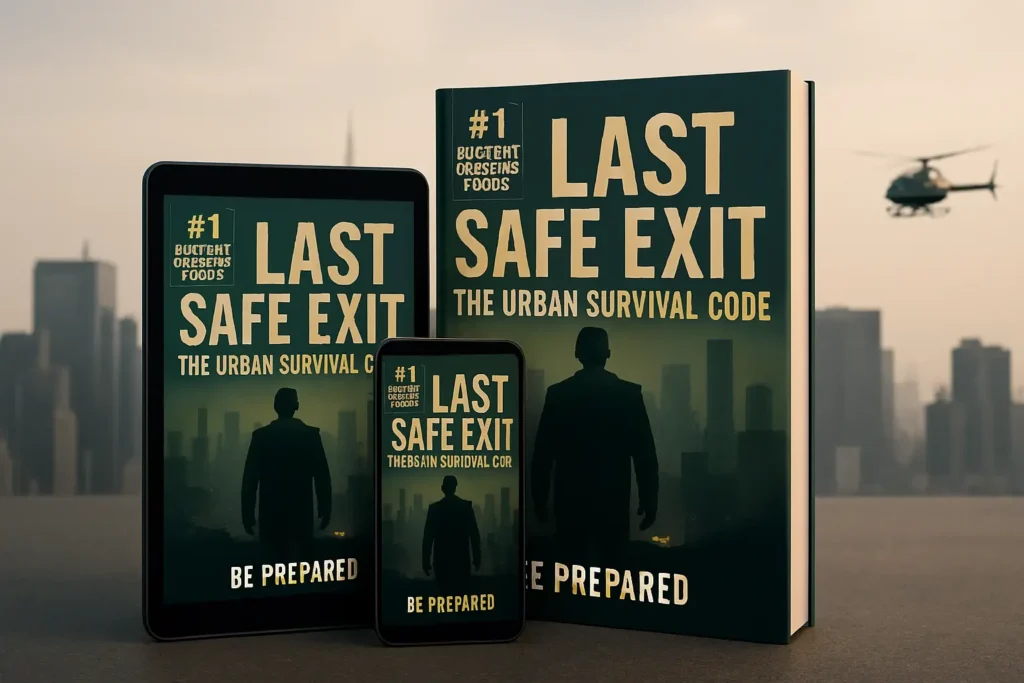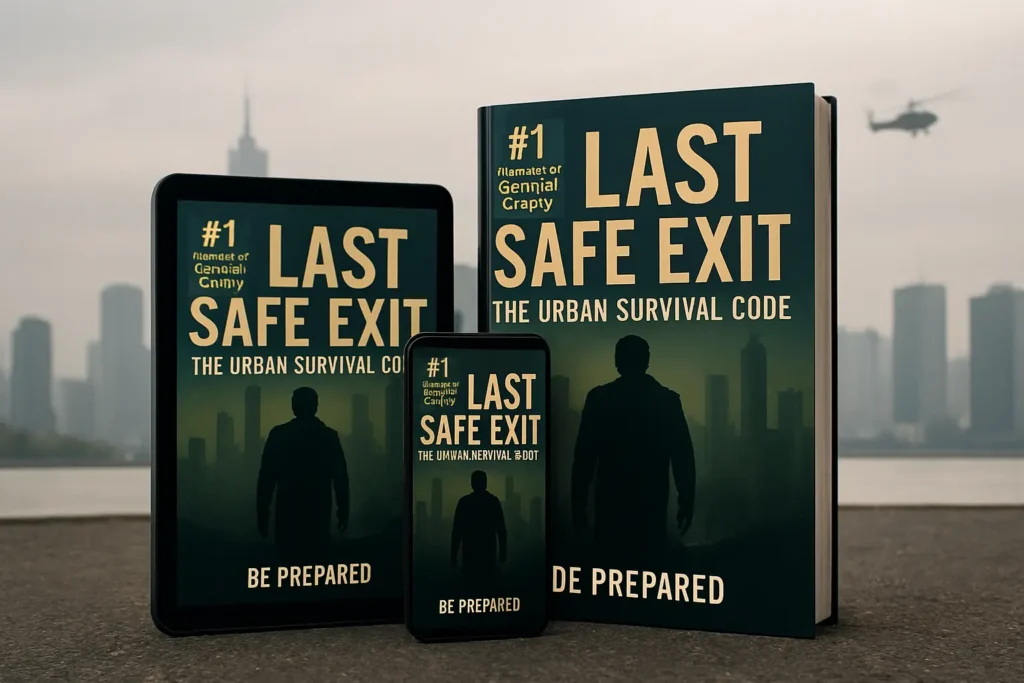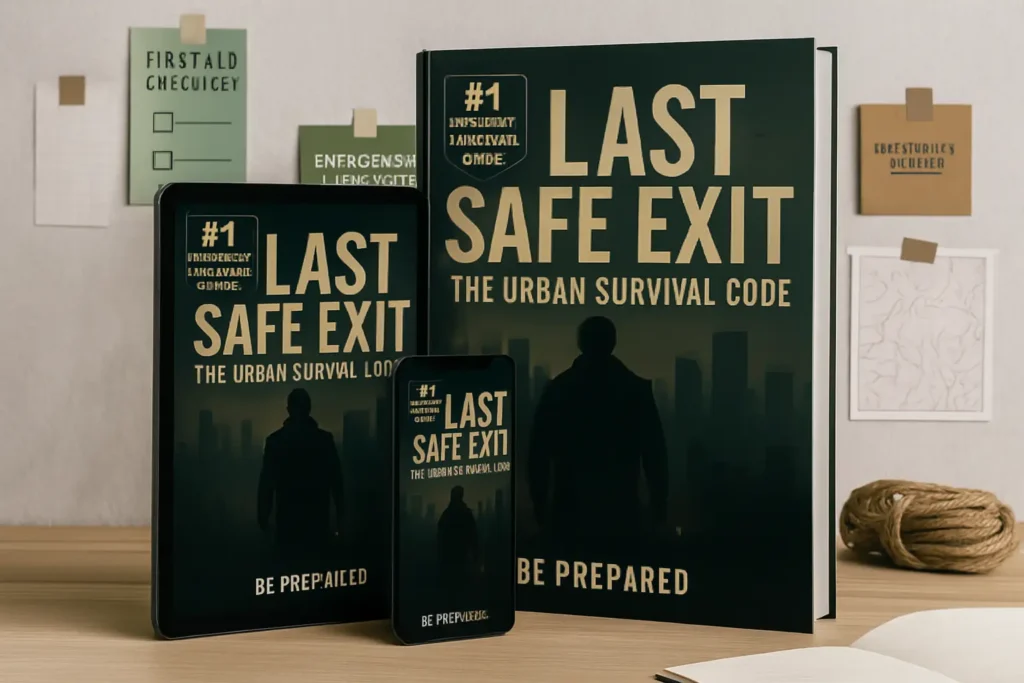The Urban Survival Code Review : Here’s what happened: I’m driving home from work last February when this massive ice storm hits Dallas. My phone dies right as the GPS cuts out, power lines are snapping left and right, and I’m sitting there thinking “Well, shit. I have zero clue how to get home without Siri telling me where to turn.”
Pretty embarrassing for someone who’s supposed to know about emergency stuff, right?
I’m Marcus, been doing disaster response work for about fifteen years. Started with FEMA back when I thought I knew everything about emergencies. Spoiler alert: I didn’t know jack about actually surviving in my own city when things went sideways.
That ice storm was my wake-up call. Got me digging into this whole urban survival thing, which eventually led me to test out something called “The Urban Survival Code.” Spent the last six months actually using their methods – not just reading about them like most people do with this stuff.
Here’s what I found out, including the parts they don’t advertise.
Ready to stop being helpless in your own city when disaster strikes? Don’t wait for the next power outage or GPS failure to realize you’re completely unprepared – get the practical urban survival skills that actually work. [GET THE URBAN SURVIVAL CODE NOW – ONLY $67]
Why You Should Maybe Listen to What I’m Saying
Look, I’m not some YouTube survivalist trying to sell you tactical pens. I’ve just seen a lot of disasters up close, starting with Hurricane Ike back in ’09. That was my first big deployment with FEMA, and holy crap, nothing prepares you for walking through neighborhoods that look like bombs went off.
Since then I’ve worked Joplin (that tornado was absolutely insane), Sandy in New York, bunch of those California fires, Harvey down in Houston. Each one taught me something new about how fast regular life just… stops working.
But here’s what really got my attention: the people who handled disasters best weren’t always the ones with huge stockpiles of gear. They were the ones who could think clearly when everything was chaos, who understood how their city actually functioned, and – this was key – who had solid relationships with people around them before they needed help.
Most survival content assumes you’re gonna end up lost in the woods eating tree bark. But seriously, when’s the last time you were more than a couple miles from a Starbucks? Urban disasters are totally different beasts, and that’s why this particular program caught my eye.
Why City Disasters Are Their Own Special Kind of Nightmare
After dealing with dozens of urban emergencies, I can tell you that city problems have this unique flavor of awful. Take Hurricane Sandy – Manhattan didn’t shut down because people got lost in forests. It shut down because elevators quit working, cell towers died, and suddenly nobody could figure out how to get groceries.
I watched people who could probably build log cabins from scratch completely lose their minds because they couldn’t get clean water when their building’s pumps failed. Saw PhD holders panic because they literally couldn’t navigate three blocks without Google Maps.
Urban survival isn’t about making fire from twigs or whatever. It’s about understanding systems – how electricity gets to your apartment, where your water actually comes from, what happens when supply trucks can’t get through. It’s psychology and preparation, not wilderness camping skills.
This is what made me curious about “The Urban Survival Code.” Instead of teaching me how to hunt pigeons in Central Park (seriously, some programs go there), it focused on stuff that might actually matter when city infrastructure craps out.
What You Actually Get When You Buy This Thing
Alright, let’s get into the details. The program has eight main sections, and I’m gonna give you the real story on what each one’s like.
Part One: Learning to Actually See Your City
First module is about “urban awareness” – basically learning to notice stuff you walk past every single day without seeing. They want you to start spotting building exits, police stations, places you could shelter, how crowds move around.
I’ll be honest, first week felt pretty dumb. Like, “Great, I’m walking around downtown looking for fire extinguishers like some kind of weirdo.” But after doing this for maybe ten days, something weird happened – I started seeing my city completely differently.
Found a 24-hour CVS I’d walked past literally hundreds of times. Noticed which buildings have those external generator boxes (hint: more than you’d think). Discovered there’s actually a fire station two blocks from my place that I’d somehow never registered in seven years of living here.
Sounds basic, but this awareness shift ended up being huge for everything else.
Ready to stop being helpless in your own city when disaster strikes? Don’t wait for the next power outage or GPS failure to realize you’re completely unprepared – get the practical urban survival skills that actually work. [GET THE URBAN SURVIVAL CODE NOW – ONLY $67]
Part Two: Getting Around When Your Phone Is Dead
Navigation module, and man, this one kicked my ass early on. They’re not just saying “learn to read maps” – they teach you how cities are actually laid out, using landmarks, even how transit systems work when regular routes are screwed.
My first test was trying to get from downtown Denver back to my neighborhood using only what I could see. Total disaster. Took three tries and a lot of wandering around lost before I could reliably navigate metro Denver without electronic help.
But once I figured it out? Game changer. During that GPS outage in March (yeah, those happen apparently), I was literally the only person at my office who could still get around normally. Everyone else was standing around looking helpless.
Parts Four and Five: Finding Stuff When Walmart’s Closed
Resource location modules, and this is where things got really interesting. They teach you how to spot alternative water sources in cities (not just “collect rainwater”), identify buildings that might have emergency supplies, figure out which neighborhoods are safer bets during emergencies.
Spent one weekend mapping this stuff around my area. Mind-blowing what you discover when you actually look. There’s a water treatment facility maybe half a mile from my house that I’d driven past thousands of times. Found out which local businesses have backup power. Even figured out which neighbors are probably serious preppers based on subtle signs you can spot.
The Neighborhood Network Thing
This part surprised me because most survival stuff is very “me against the world.” But this program spends real time on building community connections before you need them.
They give you actual templates for organizing meetings, ways to figure out what skills your neighbors have, frameworks for coordinating help during problems.
I was skeptical as hell about this, but I tried their approach and set up a neighborhood get-together. Eight people showed up – retired nurse, electrician, lady who grows amazing vegetables year-round. These connections have already paid off way beyond emergency prep.
Six Months of Actually Testing This Stuff
Reading about techniques versus actually using them – totally different things. I didn’t just study this program, I spent half a year actively testing everything they teach.
First Month: Building New Habits
Early exercises felt ridiculous. Walking my usual routes but forcing myself to notice details I’d ignored forever. Practicing navigation using landmarks. Identifying resources during regular errands.
But the compound effect was crazy. By month’s end, I had this completely different relationship with Denver. Instead of just moving through the city on autopilot, I was actually seeing it.
Month Two: The Navigation Challenge
This got serious. Program challenges you to navigate familiar areas using old-school wayfinding. I set myself the goal of getting anywhere in metro Denver without GPS or street signs.
Learning curve was brutal. First attempt getting from downtown to my apartment took over two hours and multiple wrong turns. But gradually I developed this intuitive feel for how the city’s laid out, where major landmarks are, how the grid works.
When that citywide GPS thing happened in March, I was ready. My coworkers were completely stranded while I navigated like nothing happened.
Ready to stop being helpless in your own city when disaster strikes? Don’t wait for the next power outage or GPS failure to realize you’re completely unprepared – get the practical urban survival skills that actually work. [GET THE URBAN SURVIVAL CODE NOW – ONLY $67]
Months Three and Four: Mapping Everything Out
Dedicated these months to systematically cataloging resources and building neighborhood relationships. Using their guidance, I identified water sources, backup power locations, medical facilities, shelter options within walking distance.
Community building took more work, but that first neighborhood meeting was breakthrough. We’ve had three more since, and several of us coordinate on security stuff and resource sharing now.
Last Two Months: Complex Scenarios
Later modules cover messier situations – extended outages, supply chain breakdowns, civil unrest. Couldn’t exactly simulate real emergencies, but I practiced their decision-making frameworks.
Most valuable part was their emphasis on staying calm and thinking systematically under pressure. Matches what I’ve learned professionally – panic usually kills more people than the actual crisis.
What This Program Actually Does Right
It’s Designed for Real Cities
Most survival education assumes you’ll end up in some remote wilderness. This program gets that 80% of Americans live in cities and deal with city-specific problems. Strategies work for apartment dwellers who take buses and haven’t seen actual wilderness in years.
Psychology Over Gear Lists
Instead of focusing on what equipment to stockpile, emphasizes mindset, awareness, adaptability. After working with disaster survivors for fifteen years, I can confirm mental resilience usually trumps physical supplies.
Works for Normal People
Doesn’t assume everyone has unlimited budgets or basement storage. Provides practical strategies for small apartments, limited income, people who can’t store months of supplies.
This accessibility matters. Most folks won’t become hardcore preppers, but they can learn useful skills and build basic preparedness.
Community Focus Instead of Paranoia
Rather than promoting isolation and paranoia, emphasizes building community resilience. In cities, neighbors are usually assets, not threats. Program gives concrete tools for building those relationships.
Where It Falls Short
Gets a Bit Paranoid Sometimes
While preparing for serious emergencies makes sense, some sections veer into “end times” territory. Civil unrest modules sometimes read like complete societal collapse is inevitable.
Most urban emergencies are temporary infrastructure failures, not civilization-ending events. More focus on realistic, common scenarios would help.
One Size Fits All Problem
Cities vary dramatically. Manhattan strategies differ from Phoenix or Seattle approaches. Program provides general principles but lacks specific guidance for different urban environments.
Coastal cities, desert cities, earthquake zones – different challenges that aren’t fully addressed.
Light on Hands-On Skills
Program excels at strategic thinking but thin on technical abilities. Basic first aid gets covered, but won’t learn equipment repair or jury-rigged solutions that could be crucial during extended problems.
How It Stacks Up Against Alternatives
Government Emergency Stuff
FEMA and Red Cross focus on supply storage and following official instructions. Assume help arrives quickly and systems resume functioning. Useful but limited.
This goes further by teaching you to function when official systems fail and help isn’t coming.
Wilderness Survival
Traditional programs teach valuable skills, but most don’t apply to cities. Knowing how to purify creek water doesn’t help during urban water contamination.
Urban focus makes this more relevant for most Americans.
Military/Tactical Training
Some survival education emphasizes combat skills and conflict scenarios. While personal security matters, this can be overkill for typical urban emergencies.
This teaches awareness and conflict avoidance rather than tactical responses.
My Honest Bottom Line
After six months testing everything, here’s my real assessment: this program delivers solid value for city residents wanting practical preparedness skills.
At $67, reasonably priced compared to weekend courses costing $300-500. Content is urban-focused, practically applicable, based on realistic scenarios rather than fantasy survivalism.
Not perfect – some sections could be more balanced, technical skills coverage limited. But for most city people, provides exactly what’s needed: practical knowledge for real urban challenges.
Won’t turn you into some post-apocalyptic badass, which is actually good. Designed for normal people dealing with infrastructure failures, supply disruptions, temporary emergencies.
My recommendation? If you live in a city and want to feel more prepared and self-reliant, this program’s worth the money. Keep expectations realistic and focus on practical applications rather than dramatic scenarios.
Confidence and skills I’ve gained over six months make it one of my better educational purchases. When the next ice storm hits, I’ll actually be ready this time.
Ready to stop being helpless in your own city when disaster strikes? Don’t wait for the next power outage or GPS failure to realize you’re completely unprepared – get the practical urban survival skills that actually work. [GET THE URBAN SURVIVAL CODE NOW – ONLY $67]
The Questions Everyone Keeps Asking
Will The Urban Survival Code work for complete beginners with no survival experience?
Yeah, definitely. I’ve recommended this to people with zero background, and they got the basic strategies working within a few weeks. Starts with simple concepts and builds up gradually. Don’t need prior experience – just willingness to practice the stuff around your city.
How much time does this urban survival training actually take?
Core content maybe 6-8 hours to go through, but real learning happens practicing over months. I’d say plan on 30-45 minutes weekly for skill practice, plus some upfront time for neighborhood mapping and stuff. Built for busy people, so time commitment stays manageable.
Is this worth paying for versus just using free government emergency prep stuff?
Government materials are good but focus on basic supplies and following official instructions. This teaches skills for when those systems break down. At $67, costs less than weekend courses while giving you city-specific knowledge you won’t find free. Investment paid off quickly for me.
What urban survival skills actually matter most for regular city people?
Based on my emergency background and testing this program – situational awareness, navigation without tech, resource location, community networking. These help with common urban emergencies like power outages and supply problems. Way more likely than wilderness scenarios.
Do these urban survival techniques help during actual natural disasters?
Absolutely. Program specifically covers urban challenges during natural disasters. I’ve used these during real emergency responses – they work for actual disaster situations. Navigation when GPS fails, finding resources when stores close, community coordination when help’s delayed.
How’s urban survival different from regular wilderness survival stuff?
Urban deals with infrastructure failures, crowd dynamics, resource scarcity in populated areas rather than exposure and foraging in nature. Cities provide different resources but unique challenges too. This program gets these differences and provides city-specific strategies instead of trying to adapt wilderness techniques.
Does The Urban Survival Code include self-defense or fitness training?
Covers personal security awareness but doesn’t include extensive self-defense or fitness. Focuses more on avoiding dangerous situations through smart decisions and situational awareness. Want combat training or intensive fitness? Need additional resources focused specifically on those areas.
Ready to stop being helpless in your own city when disaster strikes? Don’t wait for the next power outage or GPS failure to realize you’re completely unprepared – get the practical urban survival skills that actually work. [GET THE URBAN SURVIVAL CODE NOW – ONLY $67]




